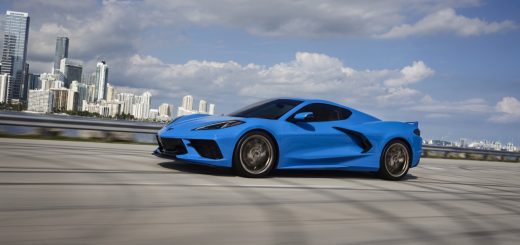Opel has announced the availability of its high performance SuperSport chassis in the Insignia mid-size line of driven by the front wheels. The SuperSport package includes GM’s HiperStrut (High Performance Strut) suspension setup, Brembo brakes, and an OPC (Opel Performance Center) tune; it was previously only available in the Insignia OPC as well as all Insignia variants with all-wheel drive, which are also equipped with traction and stability enhancing electronically controlled Limited Slip Differentials (e-LSD) to optimally distribute torque.
Now, the SuperSport chassis package can be ordered with the 2.0 CDTI diesel engine (118 kW/160 hp) as well as the 2.0 liter turbocharged gasoline engine (162 kW/220 hp). Together with the FlexRide system, which enables the driver to select from three different driving modes (Standard, Tour and Sport) to adapt the car’s damping, steering, and throttle parameters, the SuperSport chassis is a 2,930 euro option.
Most notably, HiperStrut was first used on the high performance Insignia OPC, where it significantly improved and evolved the traditional MacPherson strut front suspension. Following introduction in the Insignia OPC, HiperStrut became a standard feature in the Buick Regal GS and LaCrosse (Premium III and Touring trim levels) as well as the Opel Astra GTC and OPC. The setup reduces the kingpin inclination angle from 13 to 9 degrees, thereby shortening the spindle length by 23 mm (to 44 mm). This reduction allows the driver to more thoroughly exploit the power available in the Insignia by improving grip in wet or dry conditions as well as during high-intensity cornering maneuvers.
Reducing the kingpin angle results in a decrease in camber loss, which the front rolling stock (mostly the tires) to maintain increased contact with the road during cornering, resulting in the delay of understeer. In addition, the shortened spindle length considerably reduces torque steer reactions and improves resistance to steering kickback. For those wondering about the details of the Brembo brakes, they consist of 355 x 32 mm (14 x 1.25 inch) cross-drilled discs coupled with four-piston, high-strength aluminum calipers and high-performance brake pads.















Comments
This seems weird to me. Here in the states, the Regal Turbo already has 220 HP, but this amount of HP doesn’t warrant all these go fast performance parts. Now the Insignia is getting the option to have Brembo brakes WITH cross drilled rotors, which our GS’ don’t even have the latter. They are also getting the Hi Per struts as well. It would make more sense for Opel to bump the tune up to 270 HP with this Super Sport package. It wouldn’t tread on their Insignia OPC as it has the 300+ HP twin turbo V6. It’s decisions like this that make me wonder about GM at times
Here’s another interesting item: the Insignia’s 2.0 liter turbo LNF unit makes 250 horses in AWD configurations, basically matching the tune of the Verano Turbo. Personally, I think 220 is an embarrassing number these days for a turbo’ed 2.0.
Tune it to 250 in all Regal/Insignia applications, then introduce the Regal GS tune to the Insignia. Doing so wouldn’t hurt much of anything, either, since the torque is increased by 35 lb.-ft. from the Regal Turbo to the GS.
Yes, 220 HP is embarrassing from a turbo 4 these days. Especially with the likes of Hyundai/Kia dropping 274 HP from their turbo 4’s. The Regals need to shed some weight and get a bump in HP. AWD as an “option” would go very well here in the states.
Well, I wouldn’t generalize 220 HP as being weak from a turbo four, as I’d be more than happy to have a 1.6T making that much in a spiced-up Cruze… but 220 is definitely weak from a 2.0 turbo.
Also, the output of the Hyundai/Kia combo is not certified. They just use the highest figures based on internal calculations; I’d be willing to put money down on their hp figures dropping to the 250 level or so if SAE rated it.
As for weight, I would be cautious in cutting too much, as these are luxury cars after all. I’m all for a lower curb weight, but I guess the challenge is to drop it responsibly — without skimping on sound dampening or high quality interior materials… Interestingly, I see that doing so may be a challenge seeing that Opel may not move upmarket anymore, forcing Buick to invest some R&D time into Buick-ifying Opels.